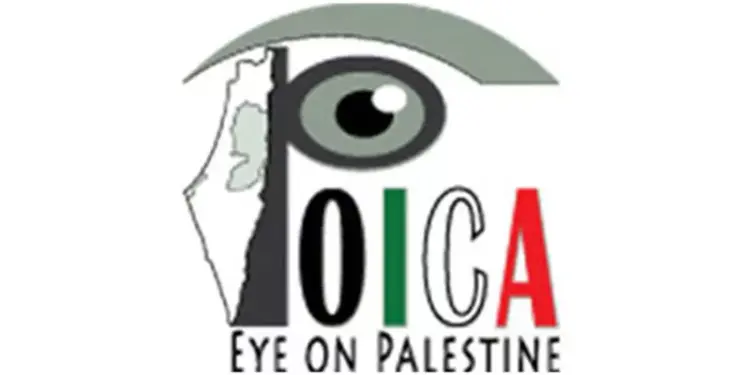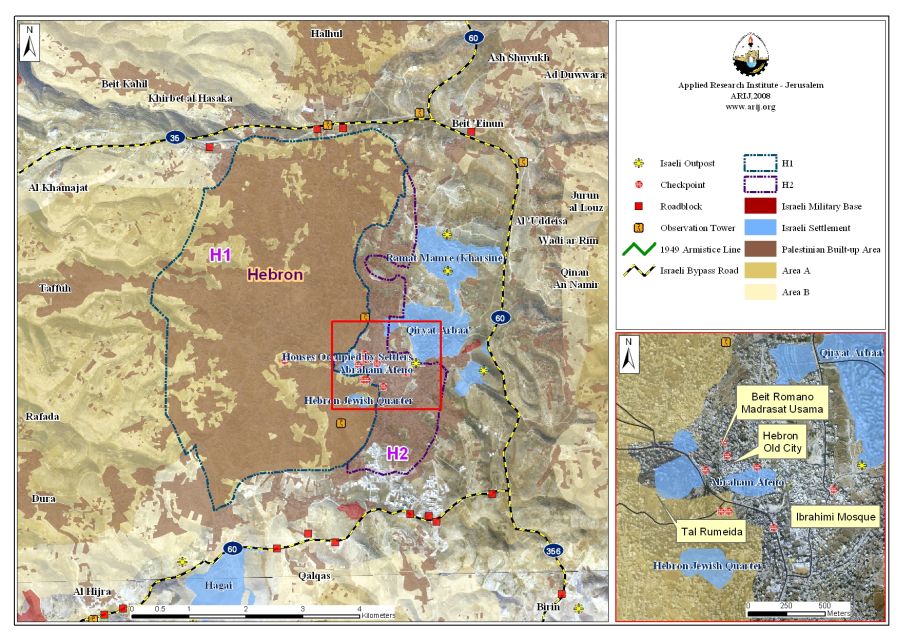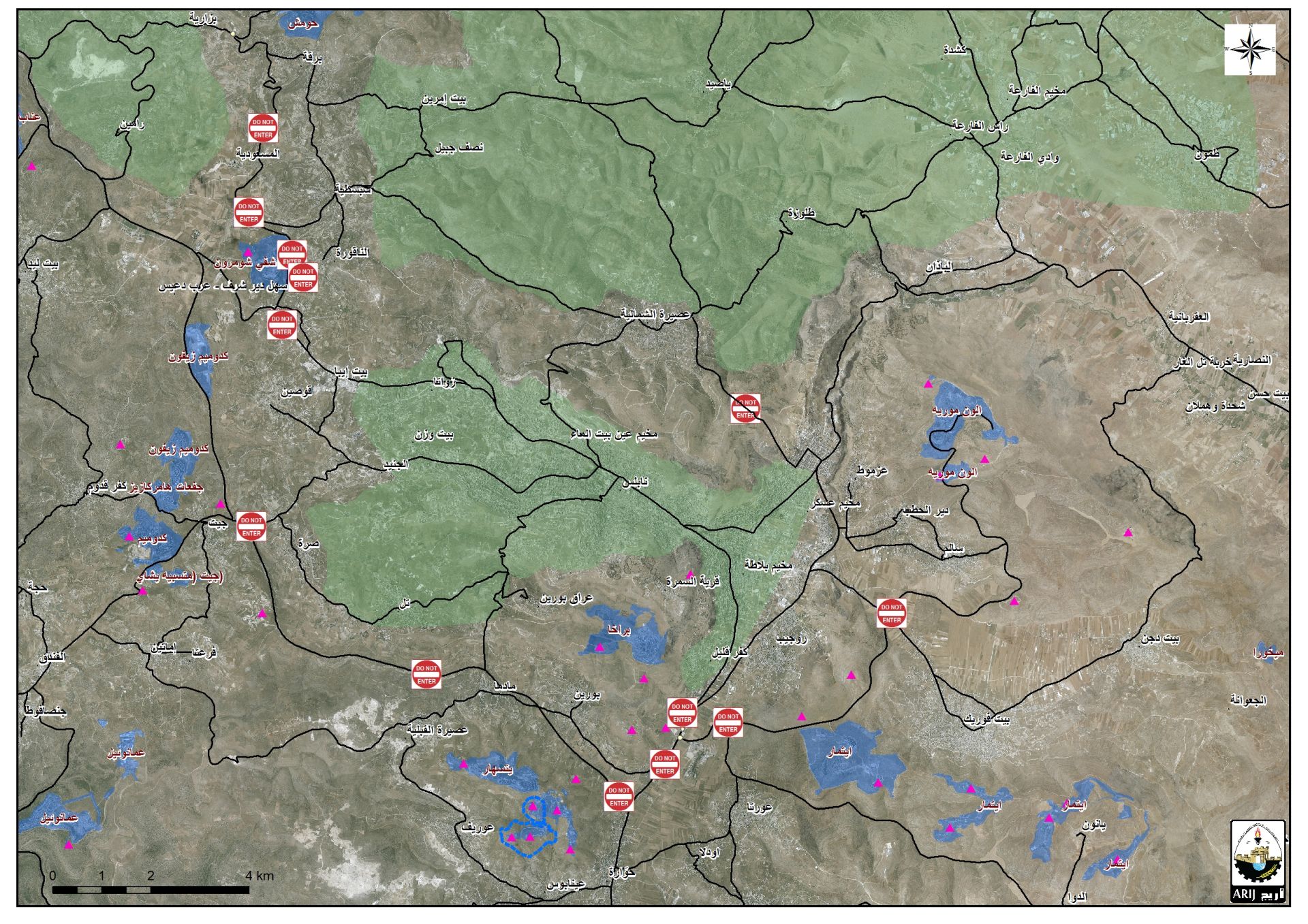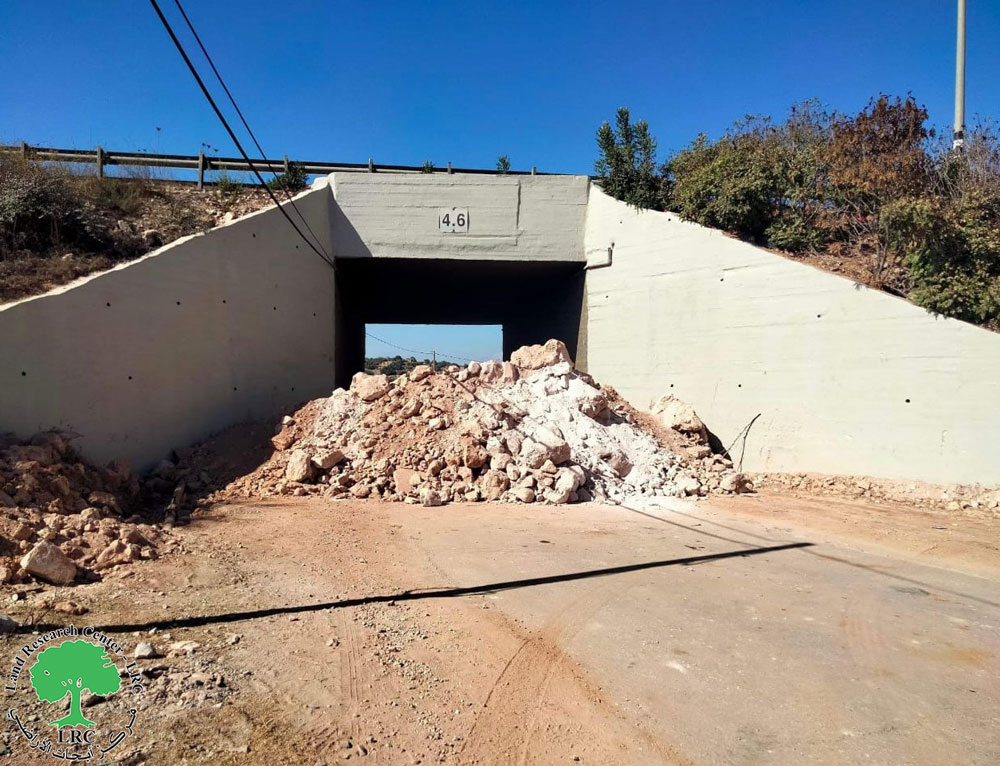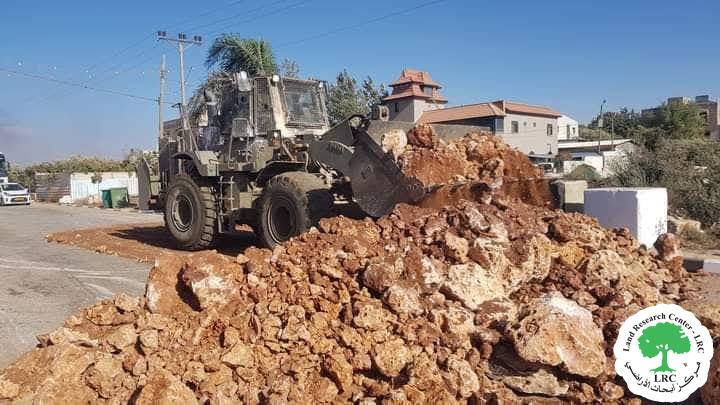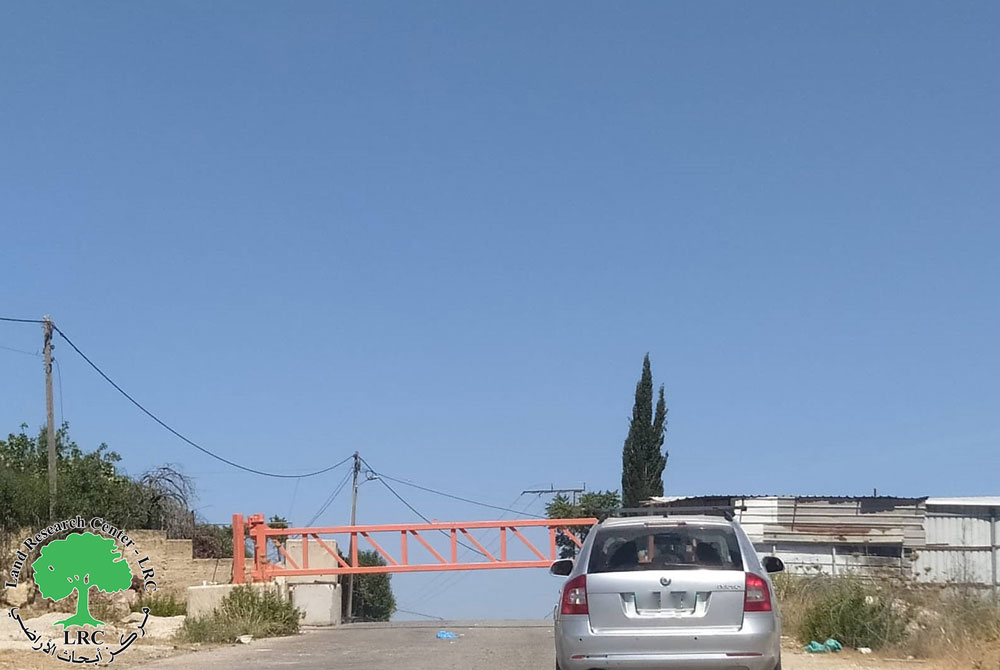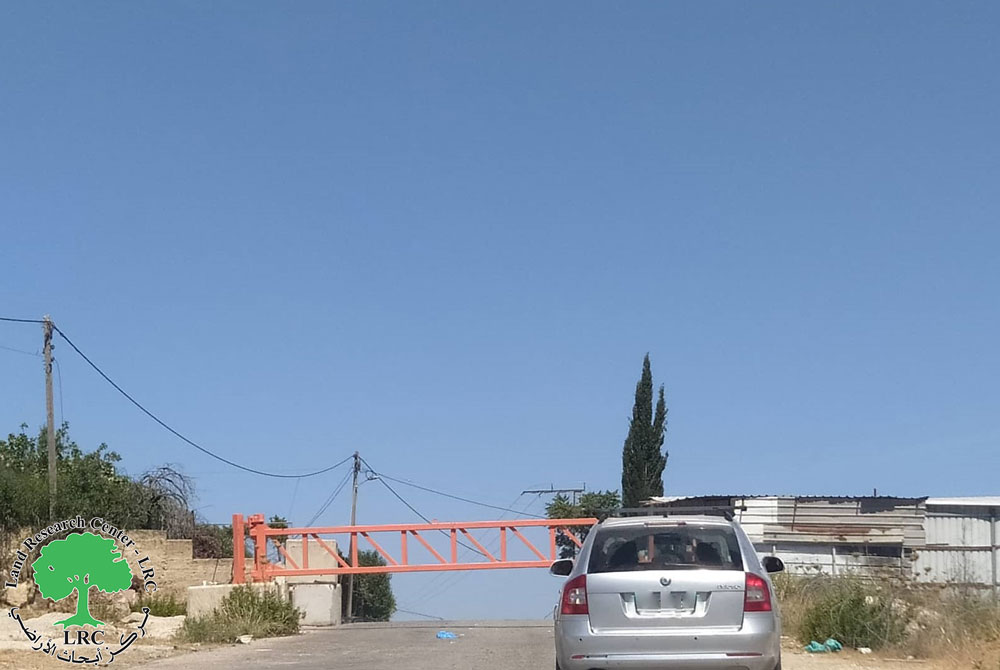Hebron is the biggest city in the West Bank, second to occupied East Jerusalem. It has more than 170.000 Palestinian inhabitants. A part from this, it is home to about 400-500 Israeli settlers (Source TIPH). Inside the Old City, the Israeli settlers dwell in four fortress settlements. The first and the biggest is Abraham Afeno. The settlers started settling there in 1968, right after the 1967-war that resulted in the occupation of the Palestinian territory. Around 1000 settlers live in the Abraham Afeno-settlement (Source: ARIJ database). The Beit Hadassa-settlement was established in 1980 (Source: ARIJ database). The settlers gained their permission from the Israeli government, when 10 Israeli women along with 40 children had been living on the location for one year (Source: TIPH). Beit Romano was also established in 1980. The Palestinians locals refer to the settlement as Madrasat Usama, as the confiscated building turned into an Israeli settlement used to be a Palestinian boy’s school, called Usama ibn Munqidh (Source TIPH). The most recent Israeli settlement to infringe the life of the Palestinians of Hebron City is Tel Rumeida-settlement, which started with caravans back in 1984 to the time it was officially sanctioned by the Israeli government to have permanent building structures in 1998 (Source TIPH).
However, the existence of the Israeli settlers goes beyond the aforementioned settlements, as the Israeli settlers occupy Palestinians' houses. As it is difficult to monitor these “mini-settlements”, it is hard to know exactly how many settlers are living like this. But the area of all the occupied Palestinian houses is set to be 65 dunums (ARIJ database).
At the outskirts of the Old City, sets the Israeli settlement Qiryat Arbaa, which accommodates more than 7000 Jewish settlers (ARIJ database).
The Israeli settlers in the Old City of Hebron are religious settlers. They chose Hebron city for being the home to the tombs of Abraham and Sara, which is a holy place in the Jewish religion. The tombs of Abraham and Sara are considered holy for Muslims and Christians as well and this made the area around the Ibrahimi mosque a point of tension and confrontations. From time to time, the mosque is closed for the Muslim worshippers, as it happens during the Jewish celebration of the New Year, which usually ranges through the months of September and October.
See map 1.
Recent developments in the settler-situation in the Old City
Israel’s adopted settlements policy in the occupied Palestinian territory is strictly forbidden by the Fourth Geneva Convention. Article 49 states that 'the occupying power shall not deport or transfer parts of its own population into the territories it occupies.' However, this does not stop the settlements-activities in Hebron Old City. During the summer of 2008, Israeli defense minister, Ehud Barak, gave permission to expand Beit Romano-settlement. The expansions include building a new dormitory for religious Jewish students (Source: The Haaretz, 03.07-2008)
Map 1: Hebron with focus on the settlements in the Old City
The settlements’ impact on the local Palestinians' daily life
The frequent problems and confrontations between the settlers and the Palestinians do not occur only in the vicinity of the Ibrahimi mosque. Instead they occur all around the Old City. The case of the Ewaiwi-family, visited several times by ARIJ-fieldworker, is a good example of the severe problems. This family lives in the heart of the Old City on the edge of a settler-area. Their roof is taken over by the Israeli soldiers who constantly watch over the family. This constant watch is extremely stressful and had a damaging effect on the family, especially on the children. The family has been the target for numerous inhuman attacks from the Israeli settlers and the Israeli soldiers stationed on the roof of the house just watched the settlers and did nothing except shoot at anyone who attempted to help the Palestinian family. The settlers’ harassments and attacks against this Palestinian family ranged from confining the family to their resident not allowing them to leave to throwing stones damaging all the windows glass and at one time the Israeli settlers set the house on fire.
Walking through the Old City of Hebron gives an indication of the severe problems this once revived market place stands today. Most of the streets in the heart of the Old City are covered with nets to protect and shield the walking Palestinians and internationals from the garbage and the rocks thrown down on them by the Israeli settler’s who occupied the upper level of the market place.
The closure of the Old City
One of the settlements’ biggest impacts on the Old City is the closure, which includes the closure of a large number of shops and the big vegetable-market and the closure of entire neighborhoods. The Old City is divided by several controlled checkpoints and other blockades. In the Israeli controlled H2-area alone, there are 78 obstacles (November 2008, Source OCHA). This makes the movement from one neighborhood to another extremely problematic for the local residents, in fact it is much more like an apartheid system where Palestinians are restricted in there movement within certain areas and not allowed to enter other areas, the Israeli Army has even channeled the Palestinians’ walking path in certain locations within the Old City. These complications combined with the frequent settler-attacks have a tendency to keep people away from the area of the Old City. What used to be a center of trade, with marketplaces and hundreds of shops, is now turning into a ghost town.
Life for storeowners in the Old City of Hebron is very difficult for several reasons they are constantly on the edge of closure. One of the main reasons is direct Israeli military orders. Since the outbreak of the second Intifada, the Israeli Army closed 512 Palestinians' stores in the Old City. Furthermore, an additional 990 other Palestinians’ stores in the area were also closed (Source: Hebron Rehabilitation Committee). This was due to the many complications and problems occurring in the Old City-area. As an example, the random shootings, especially during the second Intifada may have forced the storeowners to close their shops. The relentless and uninterrupted attacks by the Israeli settlers along with the indirect support of the Israeli Army will surly make Palestinian storeowners more hesitant to reopening their stores again.
Moreover, the big vegetable-market in the Old City is now closed. The harassment of Palestinian working in the market started back in 1994. Occasionally the market was forced to close due to clashes between the settlers and the Palestinians. These problems led to the complete closure of the vegetable-market in 2000 (Source: Hebron Rehabilitation Committee).
The National Campaign against the Israeli Closure in Hebron Old City
Due to these severe problems, a new initiative has been taken in an attempt to turn things around, the Governor of Hebron, Hebron Municipality, the Palestinian Legislative Council along with more than 70 other governmental and non-governmental institutions arranged for a campaign to started on the 2nd of November 2008 until the 9th.to revive the commercial activities in the Old City of Hebron. A large number of international representatives, including EU-parliament members and members of international solidarity movements attended the activities. Even more, Israeli politicians visited the campaign. The activities were aiming to show the world the injustice taking place in the area. This was done with different tours and visits to the Old City and the vegetable market place. There was also rising of Palestinian flags and solidarity banners throughout the Old City. The campaign went on despite of the harassment from the Israeli Army and settlers. People who participated in the legal and peaceful events risked being detained, at least 3 Palestinian students who participated in the solidarity march on the 9th of November were arrested (Source: Ma'an News). The Israeli Army tried to stop the events and declared the vicinity of the Abraham mosque as a closed military zone. Accordingly, the Israeli Army prevented the international and Palestinian representatives from touring the Old City during that week.
To conclude
The Israeli settlements in Hebron's Old City have a severe impact on the lives of the Palestinians. The difficulties for the Palestinians living side by side with the Israeli settlers are massive. Especially the closure of shops and streets are making the lives of the Palestinians very hard. The closure leaves many families without the opportunity to maintain a humane standard of living. The tension following the continuous settler-attacks on civilians is unbearable especially for the children of the Old City. The situation in Hebron's Old City, as it is now, is appalling, which is the least to say.
Prepared by
The Applied Research Institute – Jerusalem


